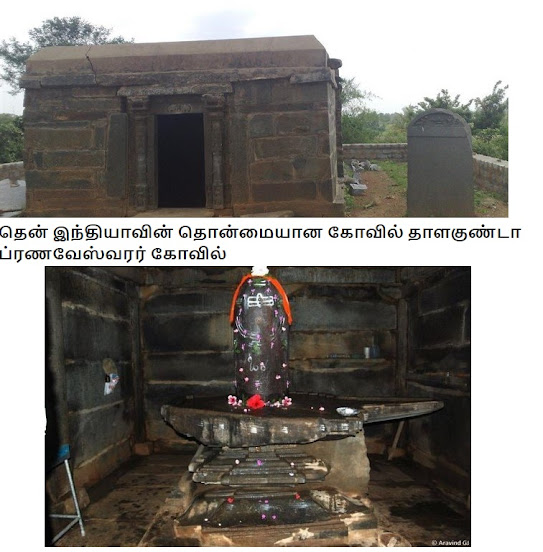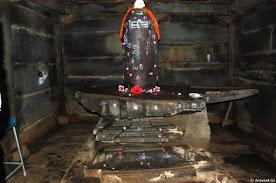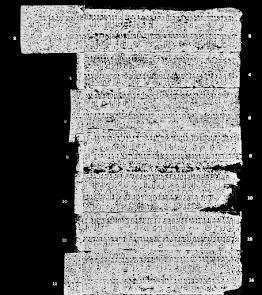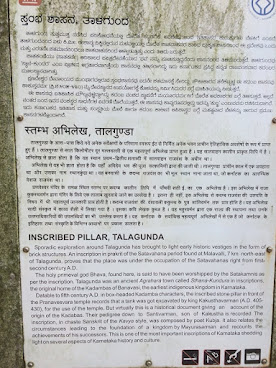கர்நாடகத்தில் ஷிமோகா அருகில் உள்ள தாளகுண்டா சிவன் கோவில் தூணில் உள்ள கன்னட கல்வெட்டு பொஆ.5ம் நூற்றாண்டு பிற்பகுதியை சேர்ந்தது.
https://www.karnataka.com/shimoga/talagunda-pranaveshwara-temple/
The inscription is engraved into a hard grey granite pillar and installed in front of a 5th-century Shiva temple. However, the temple was largely destroyed and only ruins had survived when the pillar was rediscovered in late 19th-century. The pillar is 1.635 metres (5.36 ft) high with a 0.4 metres (1.3 ft) square top.[2] It is octagonal shaft that slightly tapers and narrows as it goes up. The width of the octagonal face is 0.178 metres (0.58 ft). The inscription is on all faces, but on 7 of the 8 faces, it consists of two vertical lines that start at the bottom of the pillar. On the eighth face, there is just one short line.[2] The inscription begins with Siddham like numerous early inscriptions in India, and it invokes "Namo Shivaya".[2]
The language is excellent classical Sanskrit (follows the rules of ancient linguist Panini). The script is Kannada and the font is floral box-type.[1][2]
The inscription consists of 34 poetic verses that respect the chanda rules of Sanskrit. However, it uses a mix of meters such as Pushpitagra, Indravajra, Vasantatilaka, Prachita and others. Each verse has four padas. The inscription's first 24 verses are the earliest known use of matrasamaka meter. These features suggest that the author(s) of this inscription in South India had an intimate expertise in classical Sanskrit and Vedic literature on prosody.[2]
TRANSLATIONS[EDIT]
The earliest translation of the inscription was published in a prose form by B.L. Rice.[3] A more detailed verse by verse translation was published later by F. Kielhorn.
- B.L. Rice 1902 translation (Epigrahica Carnatica, Volume 7 Part 1, Inscription 176)
https://en.wikipedia.org/wiki/Talagunda_pillar_inscription
- F Kielhorn 1906 translation (Epigraphica Indica, Volume 8)[2]
(Be it) accomplished ! Obeisance to Shiva
(Verse 1.) Victorious is the eternal Sthanu, whose one body is framed by the coalescence of all the gods ; who is adorned with a mass of matted hair, lustrous because inlaid with the rays of the moon.
(V. 2.) After him, (victorious are) the gods on earth, the chief of the twice-born, who recite the Sama-, Rig- and Yajur-vedas; whose favour constantly guards the three worlds from the fear of evil.
(V. 3.) And next, (victorious is) Kakusthavarman, whose form is like that of the lord of the gods (and) whose intelligence is vast; the king who is the moon in the firmament of the great lineage of the Kadamba leaders of armies.
(V. 4.) There was a high family of twice-born, the circle of whose virtues, resembling the moon's rays, was (ever) expanding; in which the sons of H&riti trod the path of the three Vedas, (and) which had sprung from the gotta of Manavya, the foremost of Rishis.
(V. 5.) Where the hair was wet from being constantly sprinkled with the holy water of the purificatory rites of manifold sacrifices; which well knew how to dive into the sacred lore, kindled the fire and drank the Soma according to precept.
(V. 6.) Where the interiors of the houses loudly resounded with the sixfold subjects of study preceded by the word Om; which promoted the increase of ample chaturmasya sacrifices, burnt-offerings, oblations, animal sacrifices, new- and full-moon and sraddha rites.
(V. 7.) Where the dwellings were ever resorted to by guests (and) the regular rites not wanting in the three libations; (and) where on a spot near the house there grew one tree with blooming Kadamba flowers.
(V. 8.) Then, as the (family) tended this tree, so there came about that sameness of name with it of (these) Brahman fellow-students, currently (accepted) as distinguishing them.
(V. 9.) In the Kadamba family thus arisen there was an illustrious chief of the twice-born named Mayurasarman, adorned with sacred knowledge, good disposition, purity and the rest.
(V. 10.) With his preceptor Virasarman he went to the city of the Pallava lords, and, eager to study the whole sacred lore, quickly entered the ghatika as a mendicant.
(Vv. 11 and 12.) There, enraged by a fierce quarrel with a Pallava horseman (he reflected): Alas, that in this Kali-age the Brahmans should be so much feebler than the Kshatriyas! For, if to one, who has duly served his preceptor's family and earnestly studied his branch of the Veda, the perfection in holiness depends on a king, what can there be more painful than this? And so
(V. 13.) With the hand dexterous in grasping the kusa-grass, the fuel, the stones, the ladle, the melted butter and the oblation-vessel, he unsheathed a flaming sword, eager to conquer the earth.
(V. 14.) Having swiftly defeated in battle the frontier-guards of the Pallava lords, he occupied the inaccessible forest stretching to the gates of Sriparvata.
(V.15 and 16.) He levied many taxes from the circle of kings headed by the Great Bana. So he shone, as with ornaments, by these exploits of his which made the Paliava lords knit their brows — exploits which were charming since his vow began to be fulfilled thereby and which secured his purpose — as well as by the starting of a powerful raid.
(V.17 and 18.) When the enemies, the kings of Kanchi, came in strength to fight him, he — in the nights when they were marching or resting in rough country, in places fit for assault — lighted upon the ocean of their army and struck it like a hawk, full of strength. (So) he bore that trouble, relying solely on the sword of his arm.
(V. 19.) The Pallava lords, having found out this strength of his as well as his valour and lineage, said that to ruin him would be no advantage, and so they quickly chose him even for a friend.
(Y. 20.) Then entering the kings' service, he pleased them by his acts of bravery in battles and obtained the honour of being crowned with a fillet, offered by the Pallavas with the sprouts (pallava) of their hands.
(V. 21.) And (he) also (received) a territory, bordered by the water of the western sea which dances with the rising and falling of its curved waves, and bounded by the (?) prehara, secured to him under the compact that others should not enter it.
(V.22 and 23.) Of him — whom Shadanana, whose lotus-feet are polished by the crowns of the assembly of the gods, anointed after meditating on Senapati with the Mothers — the son was Kangavarman, who performed lofty great exploits in terrible wars, (and) whose diadem was shaken by the white chowries - of all the chiefs of districts who bowed down (before him).
(V. 24.) His son was Bhagiratha, the one lord dear to the bride — the Kadamba country, Sagara's chief descendant in person, secretly born in the Kadamba family as king.
(V. 26.) Now the son of him who was honoured by kings was the earth's highly prosperous ruler Raghu, of widespread fame ; who, having subdued the enemies, by his valour, like Prithu, caused the earth to be enjoyed by his race.
(V. 26.) Who in fearful battles, his face slashed by the swords of the enemy, struck down the adversaries facing him ; who was well versed in the ways of sacred lore, a poet, a donor, skilled in manifold arts, and beloved of the people.
(V. 27.) His brother was Bhagiratha's son Kakustha, of beautiful form, with a voice deep as the cloud's, clever in the pursuit of salvation and the three objects of life, and kind to his lineage; a lord of men with the lion's gait, whose fame was proclaimed on the orb of the earth.
(V. 28.) Him, to whom war with the stronger, compassion for the needy, proper protection of the people, relief of the distressed; honour paid to the chief twice-born by (the bestowal of) pre-eminent wealth, were the rational ornament of a ruler (who wished to be) an ornament of his family, kings thought to be indeed Kakustha, the friend of the gods, descended here.
(V. 29.) As herds of deer, oppressed by the heat, when they enter a cluster of trees, have their minds delighted by the enjoyment of the shade and find comfort, so kinsmen with their belongings, who were waylaid by the stronger, had their minds relieved and found shelter, when they entered his territory.
(V. 30.) And in his house which contained manifold collections of choice wealth, the gateways of which were perfumed with the rutting juice of lordly elephants in rut, (and) which gaily resounded with music, the lady Fortune delighted to stay steadfast, for very long.
(V. 31.) This sun of a king by means of his rays — his daughters — caused to expand the splendid lotus-groups — the royal families of the Guptas and others, the filaments of which were attachment, respect, love and reverence (for him), and which were cherished by many bees — the kings (who served them)?
(V. 32.) Now to him, favoured by destiny, of no mean energy, endowed with the three powers, the crest-jewels of neighbouring princes bowed down (even) while he was sitting quiet — they who could not be subdued by the other five measures of royal policy together.
(V. 33.) Here, at the home of perfection of the holy primeval god Bhava, which is frequented by groups of Siddhas, Gandharvas and Rakshas, which is ever praised with auspicious recitations of sacred texts by Brahman students solely devoted to manifold vows, sacrifices and initiatory rites, (and) which was worshipped with faith by Satakarni and other pious kings seeking salvation for themselves, that king Kakuathavarman has caused to be made this great tank, a reservoir for the supply of abundant water.
(V. 34.) Abiding by the excellent commands of that (king's) own son, the wide-famed glorious king Santivarman whose beautiful body is made radiant by the putting on of three fillets, Kubja has written this poem of his own on the surface of the stone.
Obeisance to the holy Mahadeva who dwells at Sthanakundura ! May joy attend this place, inhabited by men come from all the neighbourhood ! Blessed be the people !
Pranavesvara Temple, Talagunda
DISTRICT: Shimoga; TALUK: Shikarpur LOCALITY: Talagunda (Lat. 15O 35’ n; Long. 74o 18’ E)
APPROACH: AIRPORT: Bengaluru; RAILWAY STATION: Shimoga; BUS STATION: Shiralakoppa
Talagunda was an ancient agrahara town called as Sthana-Kundura in Kadamba inscriptions, the original home of the Kadambas of Banavasi, the first indigenous kingdom in Karnataka. Sporadic explorations around Talagunda has brought to light Early Historic vestiges in the form of brick structures. An inscription in Prakrit of the Satavahana period found at Malavalli, 7 km north-east of Talagunda, proves that the place was under the occupation of the Satavahanas right from 1st- 2nd century AD. The holy primeval god Bhava, found here, was said to have been worshipped by the Satakarnis in an inscription.
The Pranavesvara temple is a small square austere building with a garbhagriha and a sukanasi. The garbhagriha houses a large Siva-linga on a Bhadra pitha. The epigraphical evidence says that the Shivalinga in the garbhagriha was worshipped from the rule of Satakarni rulers and it appears to have been constructed around 4th century AD. A Sanskrit inscription in box-headed characters with an invocation to god Pasupati engraved on the right door-jamb of the Pranavesvara temple, registers a grant of money for feeding thirty residents of Sthanakunjapura by Kakustha of the Bhatari family who was a feudatory of the Kadamba king.
Praneshwara Temple Talagunda.
Talagunda was known as Sthanagundur and it was a place of religious learning or agrahara. This place is the earliest agrahara found in the state of Karantaka.
Pranaveshwara Temple- Overview
Talagunda was a place where subjects like Vedas, Vedanta, grammar and philosophy were taught under a Gurukul system. The Kannada language was taught here at the primary level. Students and teachers were also distributed food and clothes over here.
Pranaveshwara Temple – History
This temple is a highly respected shrine of Lord Shiva. There is a stone slab with inscriptions next to the temple. There is also a pillar with inscriptions in Sanskrit in front of the temple. The inscriptions were made in the mid 5th century under the rule of Santivarma by Kubja, a court-poet.
The inscriptions describe Kadambas as Brahmins who had turned into conquerors and they praise Brahmins as “Gods on Earth”, and speakers of Rig, Sama and Yajur Vedas. The Kadambas, the foremost Kannada dynasty, were Hindu in origin and the earliest known temples in Karnataka are connected to them. The town of Talagunda in the Shimoga district is believed to be the original home to the Kadambas.
How to Get to Pranaveshwara Temple
Talagunda is located in the Shikaripura taluk of Shimoga district in Karnataka. The village of Talagunda is located around five kilometers away from Balligavi. Balligavi is around 72 km from Shimoga and 12 km from Shikaripura town in Shikaripura taluk.
The Talagunda is a very popular tourist spot in the Shimoga district with hundreds of devotees visiting the Pranaveshwara temple every year. The best time to visit Shimoga is in October as the weather gets especially pleasant at this time.
http://asibengalurucircle.in/pranavesvara-temple-talagunda
https://en.wikipedia.org/wiki/Talagunda_pillar_inscription#/media/File%3A455%E2%80%93470_CE_Talagunda_Pillar_Sanskrit_inscription%2C_Pranavesvara_temple_ruins%2C_Karnataka.jpg
https://www.karnataka.com/shimoga/talagunda-pranaveshwara-temple/








